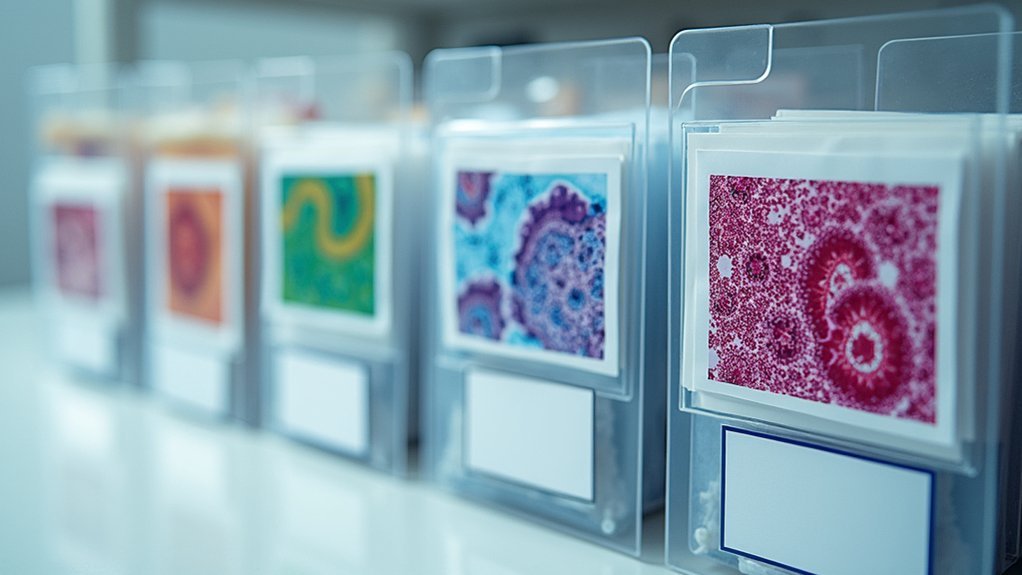Organizing lab photos with hierarchical folders dramatically improves your workflow efficiency by reducing search time and preventing broken file links. You’ll benefit from logical categories that enhance image organization while consistent naming conventions provide immediate context. This structure enables seamless collaboration through an understandable system that separates microscope types, specimens, and experimental conditions. Your team can quickly locate specific images without confusion or wasted effort. The right organizational approach transforms how you manage microscopy data.
6 Second-Level Headings for “Why Organize Lab Photos With Hierarchical Folders?”

While managing lab photos might seem like a trivial task, implementing a hierarchical folder structure dramatically improves your workflow efficiency. By organizing your images into logical categories, you’ll reduce search time and prevent broken file links that plague up to 50% of poorly organized systems.
Effective data management requires clear folder hierarchy that categorizes images by project, date, or subject matter. You’ll want to establish consistent file naming conventions such as “yyyy-mm-dd_event” to provide immediate context and enable efficient sorting. This structured approach makes collaboration seamless as team members can quickly navigate a system everyone understands.
Consider complementing your folders with a tagging system for multifaceted searches. This combination allows you to filter images based on various attributes, making your extensive photo collection accessible and truly useful for ongoing research.
The Single-Question Approach to Microscopy File Organization
Why do scientists struggle to find their microscopy files when they need them most? The answer often lies in disorganized folder structures that lack a clear organizing principle.
Many scientists discover their microscopy data is lost, not in their computer files, but in the chaos of poor organizational systems.
The Single-Question Approach offers a powerful solution by ensuring each folder addresses only one specific research question.
- Create folders that answer just one question, making context immediately clear
- Design consistent folder names that reflect the specific inquiry they contain
- Structure your files so related information stays together, reducing search time
- Avoid ambiguous categories that might confuse future users (including yourself)
- Use File names that complement your folder organization for maximum findability
Building an Efficient Hierarchy for Different Microscope Image Types

Because microscopes generate diverse image types with unique properties, you’ll need a robust hierarchical folder system to keep everything accessible.
Start by creating primary folders for each microscope type (light, electron, fluorescence), then add subfolders for specimen categories or experimental conditions.
Implement consistent file naming conventions that include essential metadata like date, sample ID, and experimental parameters. This research data management approach prevents misplacement and duplication, especially in shared lab environments.
Your file organization structure should reflect your specific research workflow while maintaining flexibility.
When multiple team members can quickly locate and understand image context, you’ll notice improved efficiency and documentation quality.
These best practices not only streamline your daily operations but also support research integrity and reproducibility standards.
Standardizing File Naming Conventions for Quick Retrieval
You’ll find your lab photos much faster when you implement date-based naming conventions like “yyyy-mm-dd” format at the beginning of each filename.
Add descriptive metadata elements such as run numbers, sample types, or experimental conditions to provide essential context without cluttering the filename.
These standardized naming practices will help you instantly recognize file contents while enabling automatic chronological sorting in your file system.
Date-Based Consistency
Since laboratory research progresses chronologically, adopting a standardized date-based naming convention for your photos creates an intuitive retrieval system.
When you implement a “yyyy-mm-dd” format, you’ll establish date-based consistency that aligns with your experimental timeline and streamlines file management.
- Use “yyyymmdd-hhmmss-seq-filename.ext” to capture both date and context in each file
- Create a folder hierarchy with year/month/day subfolders to minimize navigation clicks
- Preserve original file names as prefixes to maintain camera model identification
- Organize event-based photos in flat folders for direct access
- Place miscellaneous images in monthly folders for balanced structure
This systematic approach guarantees you’ll quickly locate specific images from particular timeframes, enhancing your workflow efficiency while maintaining contextual clarity throughout your research documentation.
Descriptive Metadata Elements
Effective file naming transforms scattered lab photos into an organized, accessible archive when you incorporate descriptive metadata elements into standardized conventions. By including identifiers like date, project code, and equipment type, you’ll quickly locate files without traversing through complex folder structures.
| Metadata Element | Benefit |
|---|---|
| Date (yyyy-mm-dd) | Places related files together in year folders |
| Project Code | Groups experiments regardless of timeline |
| Equipment ID | Identifies instrument-specific images |
| Version Number | Tracks image modifications clearly |
Start filenames with priority information for efficient sorting. While you might organize by year folder initially, your descriptive file metadata guarantees images remain findable even when shared outside your organization’s structure. This approach reduces ambiguity and improves retrieval speed, especially in collaborative environments where multiple researchers access the same photo library.
Balancing Depth and Breadth in Your Microscopy Folder Structure

The architecture of your microscopy folder system directly impacts how efficiently you can retrieve critical images during research and analysis.
When designing your folder structure, make every effort to provide a balance that minimizes search time while maximizing intuition.
- Apply the Single-Question Principle—ensure files within each folder answer the same central question
- Aim for 3-4 hierarchy levels to keep track of files without excessive clicks
- Evaluate categories regularly to accommodate evolving research needs
- Avoid folder overload—too many subfolders create navigation frustration
- Create distinct categories based on your workflow (specimen type, technique, date)
Remember that the ideal structure isn’t static—revisit and refine as your research progresses to maintain an organized system that serves all lab collaborators.
Implementing Domain Separation for Multi-User Microscopy Labs
When multiple researchers share microscopy equipment, image management quickly becomes complex without proper boundaries.
Like keeping your tax returns separate from everyday documents on your operating system, you’ll need distinct folder hierarchies for each lab user.
Create a domain-based structure where each researcher has their own designated space for data storage. This approach prevents accidental crossover between users’ projects and greatly reduces the risk of misplacing essential microscopy files.
Domain isolation gives each researcher their own digital territory, preventing data mix-ups and protecting critical microscopy assets.
You’ll find that well-implemented domain separation enhances both individual productivity and team collaboration. Users can easily share specific galleries while maintaining the integrity of their primary data repositories.
This organization method also helps your lab adhere to standardized protocols for data management—ensuring everyone can quickly locate and access their microscopy images when needed.
Frequently Asked Questions
Why Is It a Good Idea to Organize Files Into Folders and Subfolders?
Organizing files into folders and subfolders helps you navigate efficiently, find content quickly, and maintain order. You’ll save time, reduce frustration, and improve collaboration when everyone understands where things belong.
Why Is It Important to Organize Folders?
You’ll save time finding files when you organize folders effectively. It reduces mental effort, prevents duplications, simplifies collaboration, and guarantees you’ll always know where important documents are stored when you need them most.
Why Is Folder Structure Important?
A well-structured folder system saves you time, reduces frustration, and improves productivity. You’ll find files quickly, collaborate more effectively, and maintain better mental organization when your digital environment follows logical hierarchical patterns.
What Is the Best Folder Structure for Photos?
The best folder structure for photos uses a year/month/event hierarchy with consistent naming conventions. You’ll find your photos faster when you organize by date, add descriptive tags, and avoid creating too many nested subfolders.
In Summary
Your hierarchical organization isn’t just about tidiness—it’s your research lifeline. When you’ve established logical folder structures with consistent naming conventions, you’ll save hours of frustration and prevent data loss. You’re building a system that works for both quick daily access and long-term archiving. Remember, the time you invest in organizing your microscopy files today will pay dividends throughout your scientific career.





Leave a Reply